| |
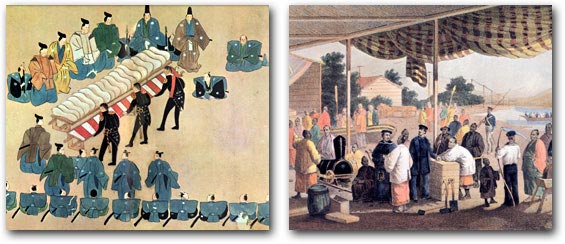 |
 Gifts
from the Japanese Gifts
from the Japanese |
Gifts
from the Americans |
 |
 Collection
of Carl H. Boehringer Collection
of Carl H. Boehringer |
from
the official Narrative |
Material culture encapsulates national culture, and this was certainly
the case in Japan’s encounter with Commodore Perry’s America.

Revolver
from the time
of Perry’s mission
Tokyo National Museum |
Even as his gunboats were forcing the Japanese to abandon their seclusion
policy, Perry was introducing them—and very deliberately so—to
the technologies essential for survival in this challenging new world.
He invited them to examine the awesome engines and gunnery on his
vessels. His officers and civilian aides took pleasure in demonstrating
Colt “six shooters,” as well as daguerreotype photography.
In
a dramatic ceremony on March 13, 1854, the commodore presented his
reluctant hosts with a variety of official gifts that ranged from
the literally tasteful (including a large quantity of liquor, as well
as “8 baskets of Irish potatoes”) to the elegantly instructive
(various books, including multi-volume sets of Audubon’s costly Birds of America and Quadrupeds of America) to the
technologically unfamiliar and imposing.
The latter presents, which naturally attracted greatest attention,
included agricultural implements, a stove, a small printing press,
a daguerreotype camera, a variety of firearms, two telegraph instruments
(with three miles of wire), and a quarter-size locomotive and tender
with passenger car and some 370 yards of track.
|
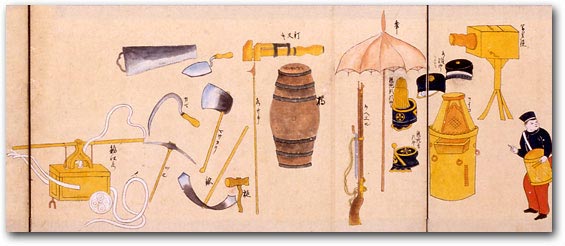 |
 |

 Perry’s
gifts, as depicted here by Japanese artists, included a telegraph
apparatus, tools, casks of liquor, firearms, headgear, umbrellas,
a stove, and a daguerreotype camera Perry’s
gifts, as depicted here by Japanese artists, included a telegraph
apparatus, tools, casks of liquor, firearms, headgear, umbrellas,
a stove, and a daguerreotype camera
Shiryo Hensanjo, University of Tokyo |
The
lithograph depicting these presents being delivered to the Japanese
in March 1854 may well be the best known of all of the official artwork
associated with the Perry expedition. (Somewhat ironically, this is
one of the few major graphics not done by Heine. It is attributed
to W. T. Peters, a little-known New York artist who did not accompany
the mission but apparently worked from one of Brown’s now lost
daguerreotypes.)
|
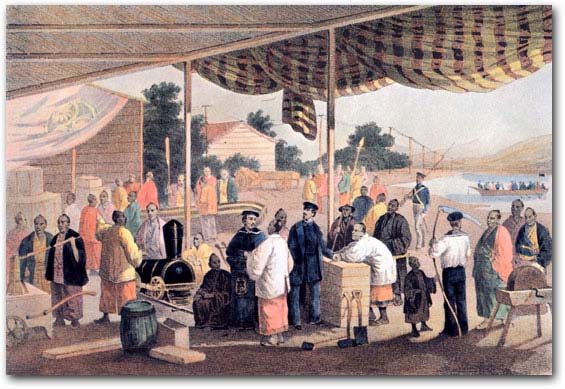 |
Delivery
of American presents at Yokohama, March 13, 1854.
Note the telegraph wires in the right background.
|
The
viewer’s eye is immediately drawn to the locomotive, surrounded
by Japanese officials dressed in kimono and short haori jackets. Its
diminutive size makes it appear to be almost a toy. Closer examination
reveals a keg of whiskey in the foreground, an American-style “Francis’
copper lifeboat” in the rear—and, in the far distance,
poles carrying the telegraph wire.
Samuel Morse, the inventor of the telegraph, personally instructed
one of Perry’s lieutenants in Morse code so that the instruments
could be set up and demonstrated in Japan.
|
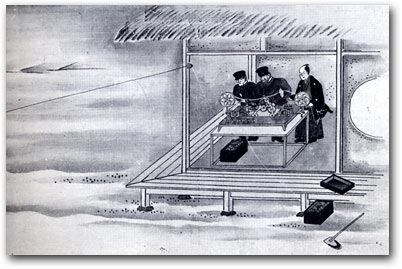
|
A samurai official observes two Americans operating the telegraph
Shiryo Hensanjo,
University of Tokyo |
As might be expected, the small-scale train attracted particularly
keen attention. By the 1870s, Japan had built its own first full-scale
railway, and real smoke-spouting passenger trains had become one of
the favorite subjects of woodblock artists of the new Japan.
|
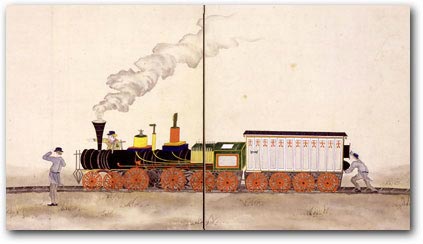 |
 |

Three Japanese renderings of
the miniature train
Shiryo Hensanjo, University of Tokyo
(top and bottom)
Ryosenji Treasure Museum (left) |
 |
The
Japanese reciprocated with gifts of their own, albeit in a manner
that served primarily to impress the Americans with the quality of
traditional crafts, the exceptional care with which the Japanese packaged
and presented things (the American gifts came in crates), and—clearly
the strongest impression—the rather curious and even coarse
nature of a great deal that was received.
The better Japanese presents included lacquered ware, porcelain, and
numerous bolts of silk (virtually all of which quickly disappeared into the bowels of a warehouse
in Washington). This was accompanied by bowls, pipes, fans, dolls,
bamboo ware, writing paper, and other commonplace articles—as
well as a number of brooms, 35 bundles of oak charcoal, 70 or so ordinary
umbrellas, 200 bales of rice, and 300 chickens.
|
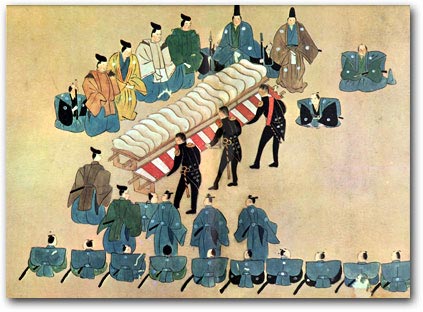 |
 Presentation
of silk to American officers, March 24, 1854 Presentation
of silk to American officers, March 24, 1854
painting on paper
Collection of Carl H. Boehringer
|
Several
small dogs of a breed that reminded the Americans of English spaniels
were given for presentation to the U.S. president, but although they
made an appearance in the Narrative, their subsequent fate remains
unclear.
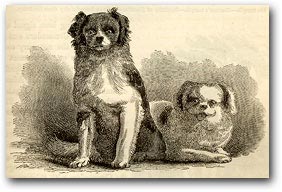
 Dogs
presented to Commodore Perry Dogs
presented to Commodore Perry
by the Japanese commissioners |
Lieutenant Preble, indefatigable chronicler of the inside story, noted
in his diary that the Japanese presents also included “a box
of obscene paintings of naked men and women, another proof of the
lewdness of this exclusive people.” These did not appear in
the official report, and their fate, too, remains unknown.
Preble’s
tepid response to the Japanese gifts was typical. He found them to
be a “pretty display,” but concluded that “one of
our presents of Audubon’s Great Work on American birds was worth
more than all we saw there, and our miniature railroad engine and
car cost several times their value.”
Everyone, the Commodore included, remarked on “the meager display
and the lack of rich brocades and magnificent things always associated with our ideas of
Japan…. I think these presents will prove a great disappointment
to our people, whose ideas of Japan have been so exaggerated.”
|
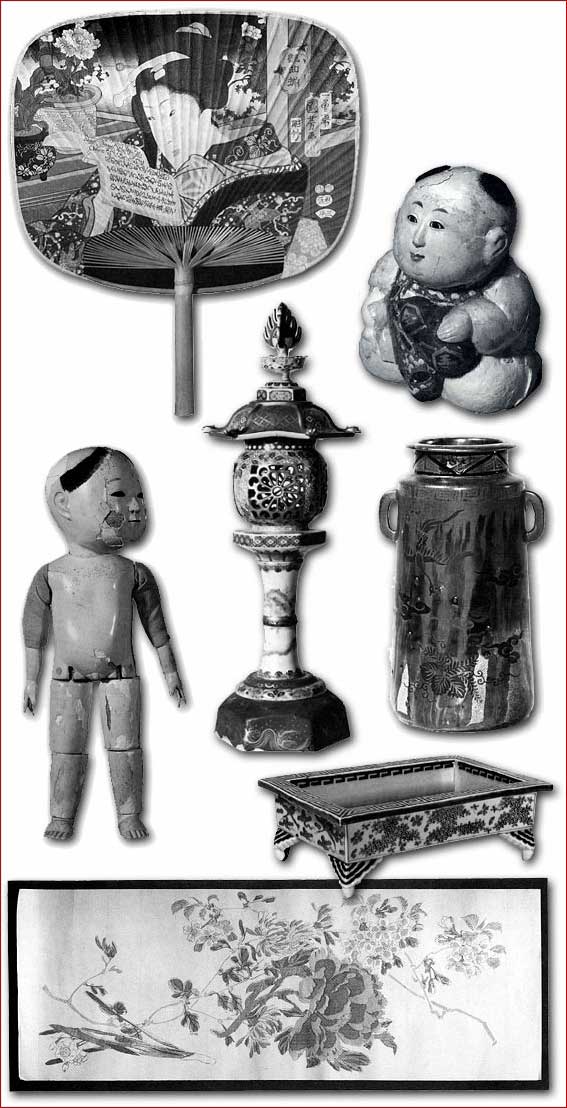 |
Japanese
gifts to the Perry expedition included various artifacts and art objects,
among them fans, dolls, ceramics, and decorated writing paper.
Smithsonian Institution
|
 List
of American Presents List
of American Presents
Brought Ashore in Japan on
March 13, 1854
For the Emperor:
Miniature steam engine, 1⁄4 size, with track, tender, and car
2 telegraph sets, with batteries, three miles of wire, gutta percha
wire, and insulators
1 Francis’ copper lifeboat
1 surfboat of copper
Collection of agricultural implements
Audubon
Birds, in nine volumes
Natural
History of the State of New York, 16 volumes
Annals of Congress, 4
volumes
Laws and Documents of the State
of New York
Journal of the Senate and Assembly of New York
Lighthouse Reports, 2 volumes
Bancroft’s History of the United States,
4 volumes
Farmers’ Guide,
2 volumes
1 series of United States Coast Survey Charts
Morris, Engineering
Silver-topped dressing case
8 yards scarlet broadcloth, and scarlet velvet
Series of United States standard yard, gallon, bushel, balances, and
weights
Quarter cask of Madeira
Barrel of Whiskey
Box of champagne and cherry cordial and maraschino
3 boxes of fine tea
Maps of several states and four large lithographs
Telescope and stand, in box
Sheet-iron stove
An assortment of fine perfumery
5 Hall rifles
3 Maynard muskets
12 cavalry swords
6 artillery swords
1 carbine
20 Army pistols in a box
Catalogue of New York State Library and
Postoffices
2 mail bags with padlocks
For the Empress:
Flowered silk embroidered dress
Toilet dressing-box, gilded
6 dozen assorted perfumery
For Commissioner Hayashi:
Audubon Quadrupeds
4 yards scarlet broadcloth
Clock
Stove
Rifle
Set of Chinaware
Teaset
Revolver and powder
2 dozen assorted perfumery
20 gallons of whiskey
1 sword
3 boxes fine tea
1 box of champagne
1 box of finer tea
For Abe, Prince of Ise, first
councilor:
1 copper lifeboat
Kendall War in Mexico and Ripley History
of the
War in Mexico
1 box of champagne
3 boxes fine tea
20 gallons whiskey
1 clock
1 stove
1 rifle
1 sword
1 revolver and powder
2 dozen assorted perfumery
4 yards scarlet broadcloth
For each of the other
five councilors:
1 book*
10 gallons of whiskey
1 lithograph
1 clock
1 revolver
1 rifle
1 sword
12 assorted perfumery
___________________________
* The books thus distributed were Lossing, Field Book of Revolution;
Owen, Architecture; Documentary History of New York;
Downing, Country Houses; and Owen, Geology of Minnesota.
The source for this list is Roger Pineau,
editor, The Japan Expedition, 1852-1854: The Personal Journal
of Commodore Matthew C. Perry, (Smithsonian Institution Press,
1968).
|
|
 List
of Articles Received List
of Articles Received
from the Japanese Government
on March 24, 1854
1. For the Government of the United States, “from the
Emperor”:
1 gold lacquered writing apparatus
1 gold lacquered paper box
1 gold lacquered book-case
1 lacquered writing table
1 censer (cow-shape) of bronze, supporting silver flower and stand
1 flower holder and stand
2 braziers
10 pieces fine red pongee
5 pieces flowered crepe
2. From Hayashi, 1st commissioner:
1 lacquered writing apparatus
1 lacquered paper box
1 box of paper
1 box flowered note paper
5 boxes stamped note and letter paper
4 boxes assorted sea shells, 100 in each
1 box of branch coral and feather in silver
1 lacquered chow-chow box
1 box, set of three, lacquered goblets
7 boxes cups and spoons and goblet cut from conch shells
3. From Ido, 2d commissioner:
2 boxes lacquered waiters, 4 in all
2 boxes, containing 20 umbrellas
1 box 30 coir brooms
4. From Izawa, 3rd commissioner:
1 piece red pongee
1 piece white pongee
8 boxes, 13 dolls
1 box bamboo woven articles
2 boxes bamboo stands
5. From Udono, 4th commissioner:
3 pieces striped crepe
2 boxes porcelain cups
1 box, 10 jars of soy
6. From Matsuzaki, 5th commissioner:
3 boxes porcelain goblets
1 box figured matting
35 bundles oak charcoal
7. From Abe, 1st Imperial councilor:
14 pieces striped-figured silk (taffeta)
8-12. From each of other 5 Imperial councilors:
10 pieces striped-figured silk (taffeta)
13. “From the Emperor” to Commodore Perry:
1 lacquered writing apparatus
1 lacquered paper box
3 pieces red pongee
2 pieces white pongee
2 pieces flowered crepe
3 pieces figured dyed crepe
14. From commissioners to Capt. H.A. Adams:
3 pieces plain red pongee
2 pieces dyed figured crepe
20 sets lacquered cups and covers
15-17. From commissioners to Mr. Perry, Mr. Portman, and Mr.
S.W.Williams, each:
2 pieces red pongee
2 pieces dyed figured crepe
10 sets lacquered cups and covers
18-22. From commissioners to Mr. Gay, Mr. Danby, Mr. Draper,
Dr. Morrow, and Mr. J.P. Williams:
1 piece red dyed figured crepe
10 sets lacquered cups and covers
23. “From the Emperor” to the squadron:
200 bundles of rice, each 5 Japanese pecks
300 chickens
___________________________
The source for this list is the official Narrative of the
Perry mission.
|
|
|

